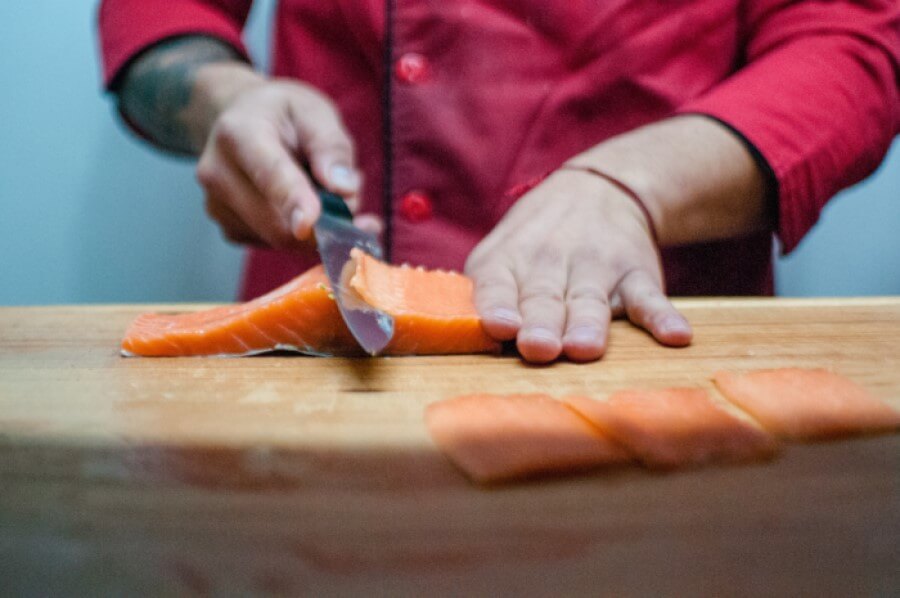There is so much information available and so many different opinions about which knife is right for slicing particular foods.
I believe that any tool you purchase for your kitchen should have a clear benefit and improve the quality of the food. Knives are a fundamental part of every kitchen, and keeping the right set of knives at your disposal will improve the quality of your home cooked meals. For example, the way you slice a brisket can completely change a person’s impression of the tenderness and flavor!
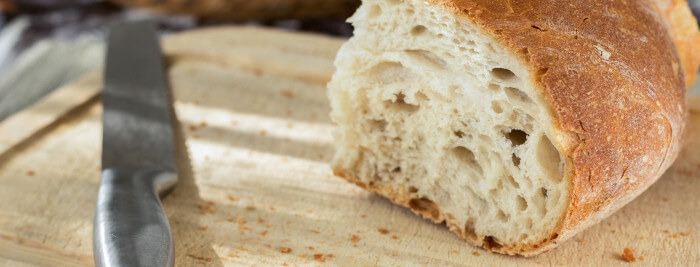
Let’s take a look at 12″+ carving and slicing knives. Why might you want a 12″ or 14″ instead of 10″? What type of edge do you need to slice bread or a whole turkey? Is there any difference between an expensive Dalstrong Slicing Knife and a more budget-friendly Victorinox? Do I want a serrated edge?
These are probably questions you’ve thought about, or at least should think about.
Choosing The Right Edge
In general, the quality of steel used to make a knife is the main factor that determines its price. Cheaper steel is softer and dulls easily. This means you’ll be straightening your blade with a honing steel more often. Honing steel doesn’t sharpen your edge, it only straightens the edge as it gets bent from use. Sharpening involves removing steel from the knife’s edge.
Next, we’re going to look at the different edge types available with slicing and carving knives. Serrated knives require a different technique and tool to be properly sharpened. If you’ve ever used a dull serrated knife to cut bread, for example, you will notice it shreds the bread instead of slicing it, which means you end up with chunks of bread and crumbs missing from your slices.
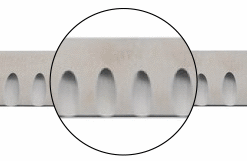
A picture is worth a thousand words, so as we take a look at the edges and how to sharpen them you’ll get a feel for what type is right for you.
After all, the best knife for you is the one you use and keep sharp!
Granton Edge on Slicing and Carving Knives
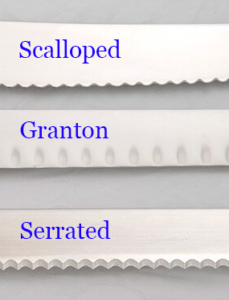
If you’re interested in a history lesson of the Granton edge, there are plenty of resources out there.
The bottom line is that the scallops in the sides of the blade extends to the edge of the blade.
Many different styles of knives have had scallops on the blade incorporated into the design, but for it to be considered a Granton edge the scallops must extend all the way to the cutting edge. The idea behind the scallops is to keep an air pocket between the knife and moist/clingy food to prevent sticking, which often leads to tearing instead of slicing.
What does all this mean for a slicing and carving knife?
Since we’re focused on long (12″+) slicing and carving knives with this article, we’re talking about slicing large cuts of meat, large loaves of bread, or even big wedges of cheese. While you can slice vegetables like cucumber, carrots, and onions with a 12″ slicing knife, this really isn’t their intended purpose. The length is overkill.
What food does a 12″+ Slicing and Carving knife with a Granton Edge cut best?
- Thinly slicing meats, such as preparing some Charcuterie
- Pork Shoulder or Leg(Ham), Beef Rib Roast, Lamb Leg or Shoulder
- Roasted Whole Chicken, Turkey, Duck, or Goose
- Brisket, Whole Beef Tenderloin, Pork Tenderloin
- Prime Rib
- Loaves of bread
These are foods you absolutely will benefit from having a long slicing and carving knife for cutting. Thinly slicing a beef brisket or carving a ham couldn’t be easier.
Depending on the “crustiness” of the bread you may be better served with by a serrated knife, but that really depends on how sharp you keep your knives. The Granton edge is more multi-purpose than serrated edge in terms of food preparation.
Sharpening Technique for a Granton Edge
You can use the typical sharpening stone and honing steel rod to maintain a sharp edge. The scalloped edge does not affect how you sharpen or straighten the blade edge. Simply be mindful of the angle you sharpen at.
Top Picks for 12″ to 14″ Slicing and Carving Knives with Granton Edge
The Icel, Victorinox and Mercer knives are similar in price, but if I can get an extra 2 inches from the the Mercer for the same price then I’ll take it. If you don’t care for the extra length and are more comfortable with the more commonly known Victorinox then you can’t go wrong. It’s a solid knife.
The Dalstrong VG10 is flashy, but the quality is superb and the scallops extend much closer to the cutting edge than the other options here. Not only that, but the scallops are wider and deeper. Best of all, you can clearly see the full tang. In my opinion, it is closer to being a true Granton Edge than the other options.
What it really comes down to is how much you’re willing to spend on a knife that you occasionally use. You may find it difficult to justify spending $120 on a knife you use on holidays and on summer occasions where you smoke a brisket. Either way you won’t be disappointed with any of these knives, but going for the longer length may help diversify your slicing toolset.
| Icel Slicing Knife with Granton Edge | Victorinox Fibrox Pro Slicing Knife with Granton Blade | Mercer Culinary Millennia Granton-Edge Slicer Knife | DALSTRONG Slicing Carving Knife – Shogun Series |
|---|---|---|---|
 |
 |
 |
 |
| 12″ Blade | 14″ Blade | 12″ Blade | 12″ Blade |
| Check Amazon | Check Amazon | Check Amazon | Check Amazon |
Scalloped Blade with Straight Edge
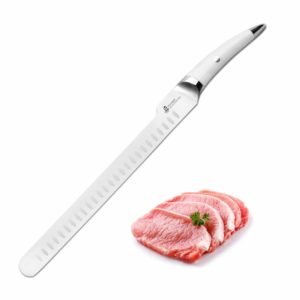
Many different knife types have scallops these days. The difference between Granton Edge and a scalloped blade is that the scallops don’t extend to the blade edge. They are often just in the middle of the blade. They don’t affect the cutting ability of the edge, but rather help keep slices of food from sticking to the blade.
You can find scallops on Santoku, Paring, Chef, and just about any other type of knife intended for slicing food.
They are easy to maintain, just like blades with a Granton Edge as they both have a straight edge.
Sharpening Technique
You can use the typical sharpening stone and honing steel rod to maintain a sharp edge. The scallops how you sharpen or straighten the blade edge. Simply be mindful of the angle you sharpen at.
Top Picks for 12″ to 14″ Slicing and Carving Knives with a Scalloped Blade
Of the 12″ options, the TUO is the best deal. You can clearly see the full tang and the curvature of the handle feel good in your hand. The 15-degree per side cutting edge is going to effortlessly slice through meat. The steel is 440A and is 2mm thick. You may be worried about the handle, but if you’re holding the knife properly it is very comfortable.
If you were looking for something a little longer, the 14″ Panderno is an excellent choice. The handle is a bit larger than the TUO, which means you have more to hold onto. The front indentation(nearest the blade) works well for positioning your middle finger when using the pinching grip shown in the link above.
| Ergo Chef Slicer Carving Knife | TUO Cutlery Japanese Slicing Knife | Wenger Swibo Slicing Knife | Paderno World Cuisine Slicing Knife |
|---|---|---|---|
 |
 |
 |
 |
| 12 Inches | 12 Inches | 12 Inches | 14 Inches |
| Check Amazon | Check Amazon | Check Amazon | Check Amazon |
Serrated Edge

You may be wondering why you might prefer a serrated knife over a straight-edge or scalloped blade. Often you will see serrated slicing knives being used to cut bread. Bread is best cut by serrations that easily pierce through the hard crust without tearing the bread. If you don’t keep your serrated knife sharp you will notice chunks being torn out as you slice, this is a hint that you should sharpen.
Serrations for slicing meat are not recommended. They tend to shred the meat, especially soft fish. The main reason to keep a serrated knife in your arsenal is for slicing bread. Just about any other job can be done with a plain edge, or maybe a scalloped edge.
What are some positive points about serrated edges? Serrations improve blade edge retention because the tips initiate the cut, which eases the force needed to cut for the recessed edge of the blade. The recessed curves of the blade will wear slower over time.
That brings us to the sharpening technique. As you might guess, the tips of the serrations will lose their edge faster. So you want to maintain the serrations while also keeping the recessed edge sharp.
Sharpening Technique
This guide is an excellent resource for the different tools and techniques you can use to sharpen a serrated knife.
Check out the video here:
At the very least, you will need a ceramic rod and tapered sharpening rod.
Lansky 8″ Ceramic Sharpening Stick
Lansky LS09735-BRK Folding/Tapered Diamond Rod
Top Picks for 12″ to 14″ Slicing and Carving Knives with a Serrated Edge
All of these options are very affordable. They are very similar in style and grip. When holding a serrated knife for slicing bread, you’re not going to be using the blade pinching grip when slicing. You will want to keep all fingers on the handle. This means the ergonomics of the handle and having a textured non-slip handle are important.
| Fat Daddios Bread Knife | Mundial Serrated Slicing Knife | Dexter Russell Scalloped Slicer | Kutler Pro Serrated Slicing Knife |
|---|---|---|---|
| 14 Inches | 14 Inches | 12 Inches | 14 Inches |
| Check Amazon | Check Amazon | Check Amazon | Check Amazon |
Scalloped Edge
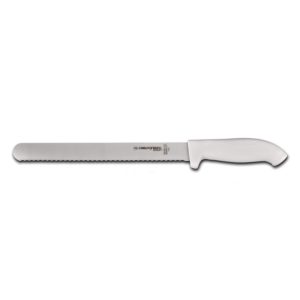
At first glance, you may wonder what the difference is between a serrated and scalloped edge. Scalloped edges are rounded and don’t have a point. Serrations have a very well defined tip.
You will often see a scalloped edge on slicing knives as they don’t shred meat like a serrated edge, and they help a blade’s edge stay sharp longer.
The wavy design of a scalloped edge is less aggressive and won’t shred food. The peak of a scallop arc initiates the cut just like the serrated edge, but since it is not as pronounced it will not dull as fast as a serrated edge. This also means it won’t aggressively cut through the crust of bread, but it’s still better than using a plain edge.
You can use a scalloped edge for just about anything a straight edge can do, with the exception of very soft meats like when preparing sashimi. There are, of course, so many different styles that this isn’t universally true. A major factor in the performance of a scalloped or serrated edge is the width of the scallops or serrations. The wider scallops will cut similar to a plain edge knife, whereas more scallops would be closer to a serrated edge.
Sharpening Technique
The video below gives you an example of how you would sharpen various types of edges, but honestly I’ve found conflicting opinions as to the best way to sharped a scalloped edge.
Using a ceramic rod in combination with a tapered sharpening rod seems to yield the best results over long periods of use. This is similar to the serrated technique above.
Here’s the problem:
Let’s say you’re using a ceramic rod and slide the scalloped edge along each side of the rod. If you do this quickly, then you will notice you’re going to hit the side of each scallop as opposed to gliding in and out of each valley of the edge. This is especially true if the scallops aren’t very wide. This technique will likely work well over time with the knife in the video since the scallops are very wide and large.
To remedy this, you can use a tapered sharpening rod to work on the valleys of the scallops and then run the ceramic rod along each side of the edge.
Top Picks for 12″ to 14″ Slicing and Carving Knives with a Scalloped Edge
| Mercer Culinary Millennia Slicer Knife | Dexter Sani-Safe Scalloped Slicer Knife | Dexter Outdoors Scalloped Slicer Knife |
|---|---|---|
| 12 Inches | 12 Inches | 12 Inches |
| Check Amazon | Check Amazon | Check Amazon |
